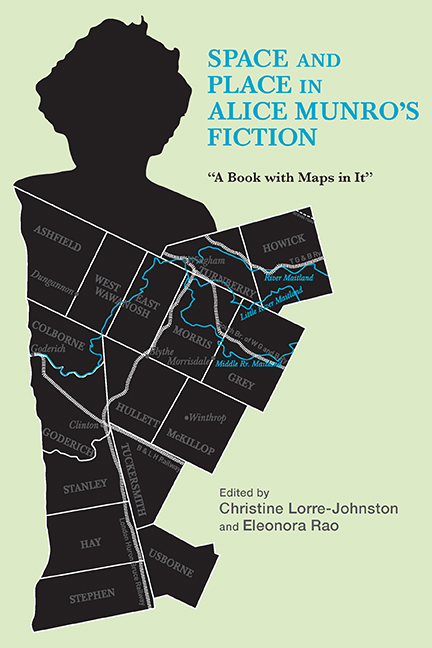Book contents
- Frontmatter
- Contents
- List of Illustrations
- Acknowledgments
- List of Abbreviations
- Introduction
- Part I Conceptualizing Space and Place: Houses, Landscapes, Territory
- 1 Where Do You Think You Are? Alice Munro's Open Houses
- 2 “Whose House Is That?” Spaces of Metamorphosis in Alice Munro's Dance of the Happy Shades, Who Do You Think You Are?, and The View from Castle Rock
- 3 Mapping the Vernacular Landscape in Alice Munro's “What Do You Want to Know For?” and Other Stories
- 4 Stories in the Landscape Mode: A Reading of Alice Munro's “Lives of Girls and Women,” “Walker Brothers Cowboy,” and “Lichen”
- 5 “What Place Is This?” Alice Munro's Fictional Places and Her Place in Fiction
- 6 “The Emptiness in Place of Her”: Space, Absence, and Memory in Alice Munro's Dear Life
- 7 Down the Rabbit Hole: Revisiting the Topos of the Cave in Alice Munro's Short Stories
- Part II Close Readings of Space and Place
- Bibliography
- Notes on the Contributors
- Index
7 - Down the Rabbit Hole: Revisiting the Topos of the Cave in Alice Munro's Short Stories
from Part I - Conceptualizing Space and Place: Houses, Landscapes, Territory
Published online by Cambridge University Press: 15 August 2018
- Frontmatter
- Contents
- List of Illustrations
- Acknowledgments
- List of Abbreviations
- Introduction
- Part I Conceptualizing Space and Place: Houses, Landscapes, Territory
- 1 Where Do You Think You Are? Alice Munro's Open Houses
- 2 “Whose House Is That?” Spaces of Metamorphosis in Alice Munro's Dance of the Happy Shades, Who Do You Think You Are?, and The View from Castle Rock
- 3 Mapping the Vernacular Landscape in Alice Munro's “What Do You Want to Know For?” and Other Stories
- 4 Stories in the Landscape Mode: A Reading of Alice Munro's “Lives of Girls and Women,” “Walker Brothers Cowboy,” and “Lichen”
- 5 “What Place Is This?” Alice Munro's Fictional Places and Her Place in Fiction
- 6 “The Emptiness in Place of Her”: Space, Absence, and Memory in Alice Munro's Dear Life
- 7 Down the Rabbit Hole: Revisiting the Topos of the Cave in Alice Munro's Short Stories
- Part II Close Readings of Space and Place
- Bibliography
- Notes on the Contributors
- Index
Summary
People's lives, in Jubilee as elsewhere, were dull, simple, amazing and unfathomable—deep caves paved with kitchen linoleum.
—Alice Munro, “Epilogue: The Photographer,” Lives of Girls and WomenTHE EPIGRAPH TO THIS ESSAY is certainly the most often quoted line from Alice Munro's fiction. In the mode of contrasts that characterizes her fiction, it juxtaposes mystery and ordinary life, the visible and the invisible, idealism and materialism, domesticity and wilderness, ancient past and modern present. It epitomizes what Munro's fiction does, evoking elusive emotions that cannot be seen and are not palpable, while anchoring itself in images of reality. It thus reads both as a metaphor and as a metafictional comment, one with programmatic value that anticipates her subsequent work as writing that focuses on seemingly ordinary individual lives to reveal the richness of them. The topos of the cave—the word “topos” being used here in the double sense of its Greek etymology, meaning “place,” and in its figurative sense of a rhetorical or literary formula, or “commonplace”—crops up recurrently in Munro's writing and appears to be complex. The word cave in some cases literally refers to a natural underground hollow, and in others is used as a simile, as part of a description of place, more often than not a house or another type of building. In all cases the motif has rich poetic potential, inscribing itself in the long literary and artistic tradition that relies on it to open the imagination. It leads to a broad metaphorical field, one that has undergone several developments, the cave being “one of the most powerful images, simultaneously complex, persistent and subtle,” in that it reflects “concepts of material, moral, religious, sexual, social and philosophical values,” to quote Florence Weinberg's study on the cave as metaphor. Furthermore, the cave, whether in a literal or figurative sense, but originally a natural formation, is to be considered together with the grotto, in the sense of an artificial and ornamental structure.
- Type
- Chapter
- Information
- Space and Place in Alice Munro's Fiction“A Book with Maps in It”, pp. 133 - 156Publisher: Boydell & BrewerPrint publication year: 2018

